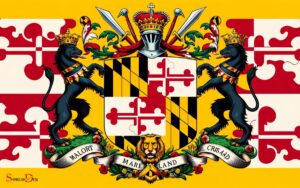What Does the Spain Flag Symbol Mean? The Nation’s Unity!
The Spain flag symbolizes the nation’s unity and history, featuring a red-yellow-red horizontal triband with the national coat of arms offset towards the hoist.
The red stripes represent strength and valor, while the yellow stripe signifies generosity. The coat of arms encompasses historical kingdoms, the Pillars of Hercules, and the motto ‘Plus Ultra.’
Explanation The flag of Spain, known as ‘la Roja y Gualda,’ has significant historical and cultural meanings.
Each element of the flag’s design is steeped in history:
- Red Stripes: Symbolize strength and bravery.
- Yellow Stripe: Represents generosity.
- Coat of Arms: Includes the emblems of the former kingdoms of Castile, León, Aragon, Navarre, and Granada, along with the fleur-de-lis of the House of Bourbon, signifying the royal family.
- Pillars of Hercules: Stand for the Straits of Gibraltar and Spain’s colonial history.
- Motto ‘Plus Ultra’: Translates to ‘Further Beyond,’ referring to Spain’s history of exploration.
For example, the Pillars of Hercules on the flag were believed to mark the edge of the known world in ancient times, symbolizing Spain’s role in expanding the horizons through exploration.
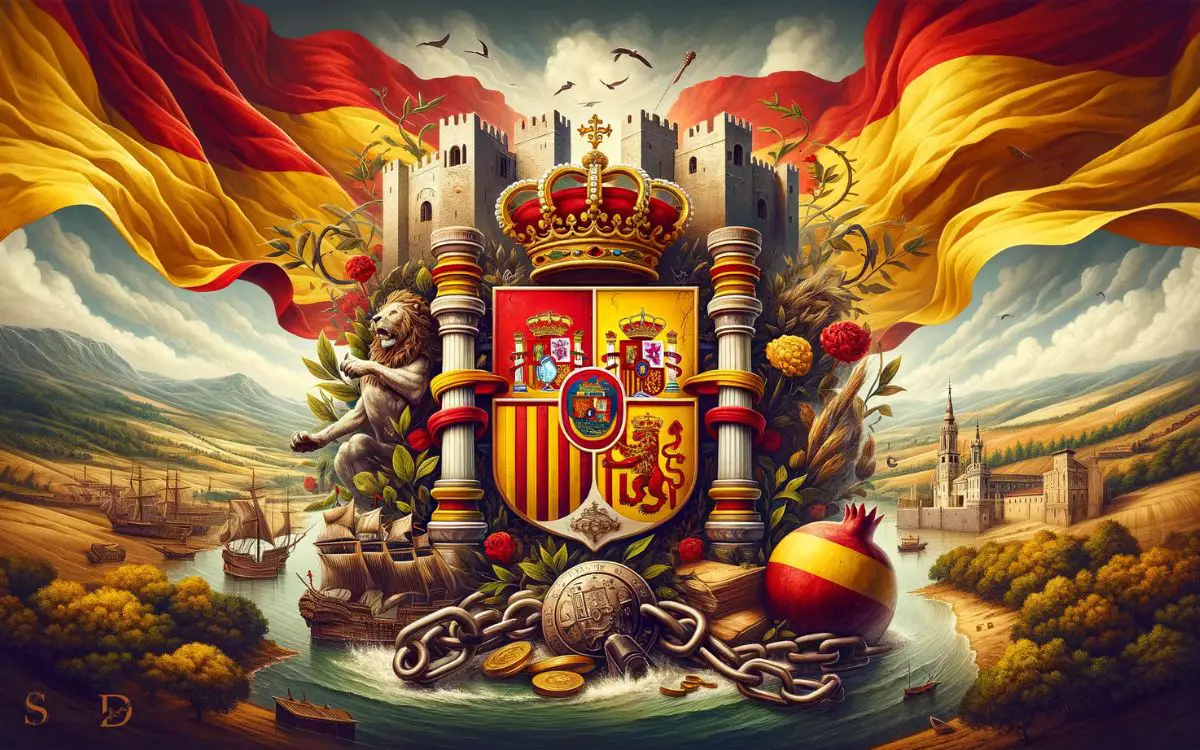
Key Takeaway
Historical Evolution of the Spain Flag
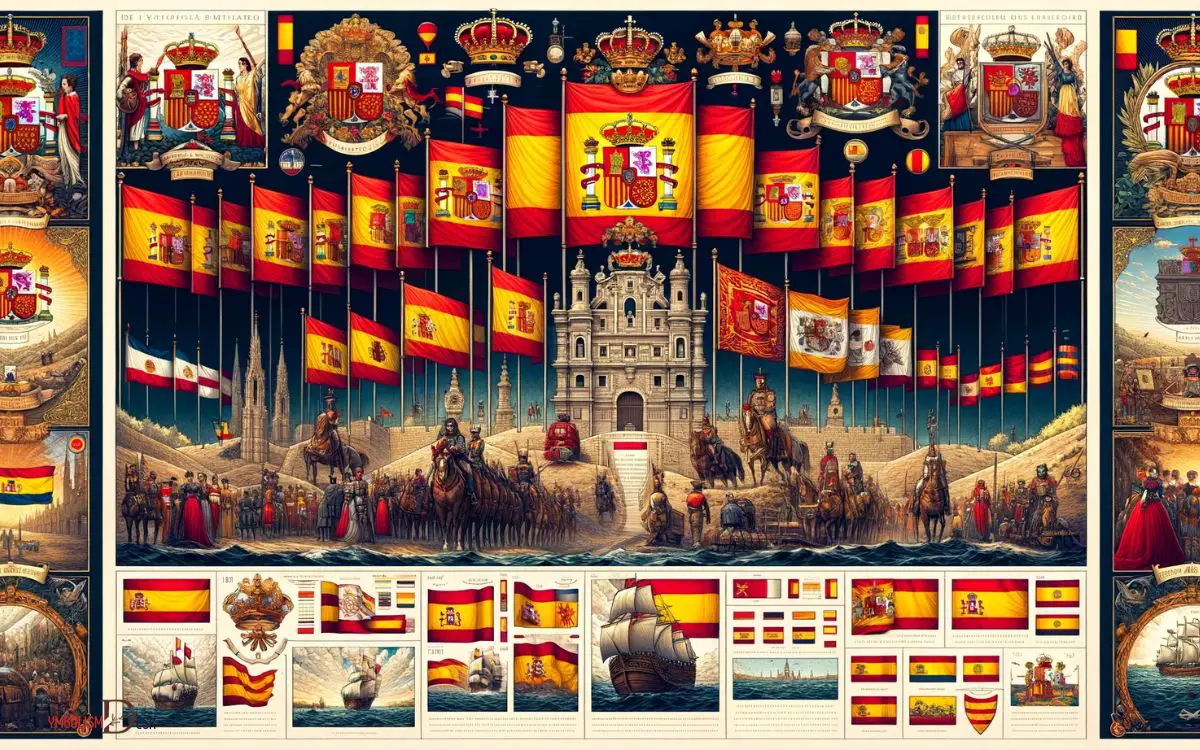
The historical evolution of the Spain flag dates back to its origins in the late 18th century. The current design, featuring three horizontal stripes of red-yellow-red, was officially adopted in 1981.
However, its roots can be traced to as early as 1785 when King Charles III established the red and yellow colors as the national standard.
The evolution of the flag has been influenced by various historical and political factors, including the union of the crowns of Aragon and Castile, as well as the subsequent colonial expansion.
Over time, the flag has come to symbolize the unity and diversity of Spain, with each color holding distinct meanings. Red represents hardiness, bravery, and strength, while yellow symbolizes generosity and the country’s wealth of resources.
The historical journey of the Spain flag reflects the rich tapestry of the nation’s past and its enduring significance.
What does the Spain Flag Symbol Mean
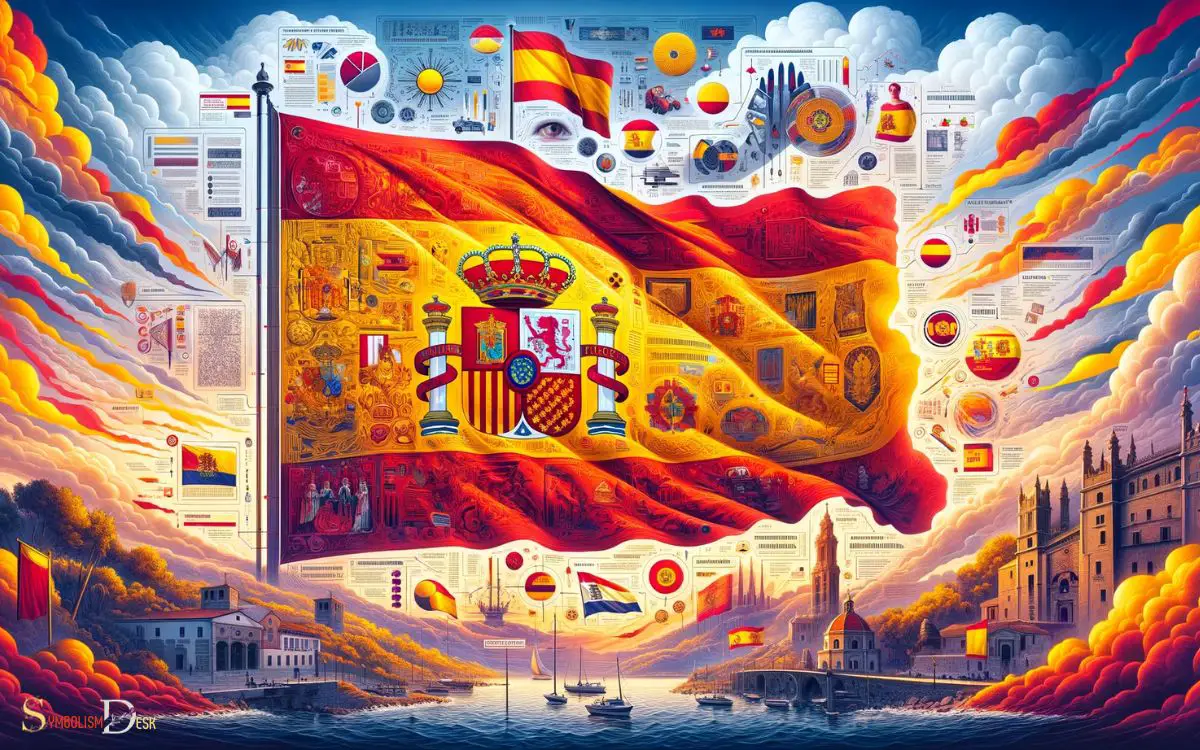
The flag of Spain, often referred to as the “Flag of Spain” or “La Rojigualda,” consists of three horizontal stripes: red at the top and bottom, with a larger yellow stripe in the middle.
The flag’s design and colors have historical and symbolic significance:
Red and Yellow Colors: The red and yellow colors in the Spanish flag have their origins in the Spanish coat of arms, which features a red lion on a yellow field.
These colors have been associated with Spain for centuries and are often referred to as “Rojo” (red) and “Gualda” (yellow).
Historical Roots: The flag’s design can be traced back to the late 18th century when it became the national flag of Spain. It was officially adopted as the national flag in 1981 when Spain transitioned to a constitutional monarchy.
However, variations of the red and yellow flag have been used in Spain for centuries, including during the period of Spanish exploration and colonization.
Historical Regions: Some interpretations suggest that the red and yellow stripes may symbolize the historical regions of Spain.
For example, the red stripes might represent the Kingdoms of Castile and Leon, while the yellow stripe could represent the Kingdom of Aragon. These were powerful regions in medieval Spain.
Unity and Identity: The flag represents the unity and identity of Spain as a nation. It is a symbol of the Spanish people coming together despite their diverse regional cultures and languages. The flag’s design, with its red and yellow stripes, recalls the traditional colors of Spain and has served as a unifying emblem for centuries. The national flag is a powerful representation of the shared values and history that bind its citizens. In the same way, the Argentina flag emblem meaning reflects the unity and identity of the Argentine people, representing their common aspirations and heritage.
The flag is a unifying symbol that is displayed proudly on various occasions, such as national holidays and sporting events.
Modern Interpretation: In modern times, the flag is often associated with Spain’s democratic government and its role as a member of the European Union and the international community. It is a symbol of Spanish national pride and is flown throughout the country.
Overall, the flag of Spain is a symbol of the nation’s history, culture, and unity. Its colors and design have deep historical roots and are an important part of Spain’s national identity.
Colors and Design of the Flag
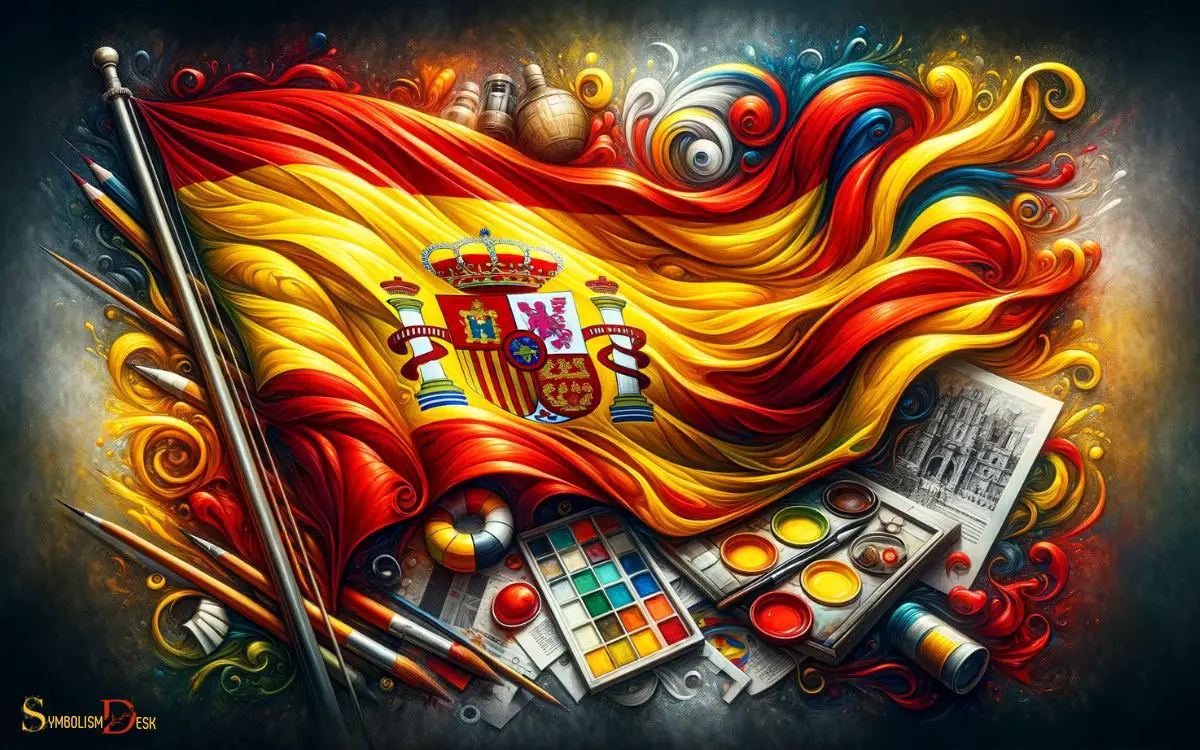
The flag of Spain consists of three horizontal stripes of red, yellow, and red, representing distinct symbolic meanings.
The colors and design of the flag hold significance in Spanish history and culture:
- Red: Represents the bloodshed of those who fought for Spain throughout its history.
- Yellow: Symbolizes the sun and the wealth of the country.
- Design: The proportions of the flag are defined by law, ensuring consistency and authenticity in its representation.
Understanding the colors and design of the Spain flag provides insight into the rich symbolism embedded within it. These elements contribute to the flag’s significance and the pride it instills in the Spanish people.
Now, let’s delve into the deeper symbolism of the Spain flag.
Symbolism of the Spain Flag
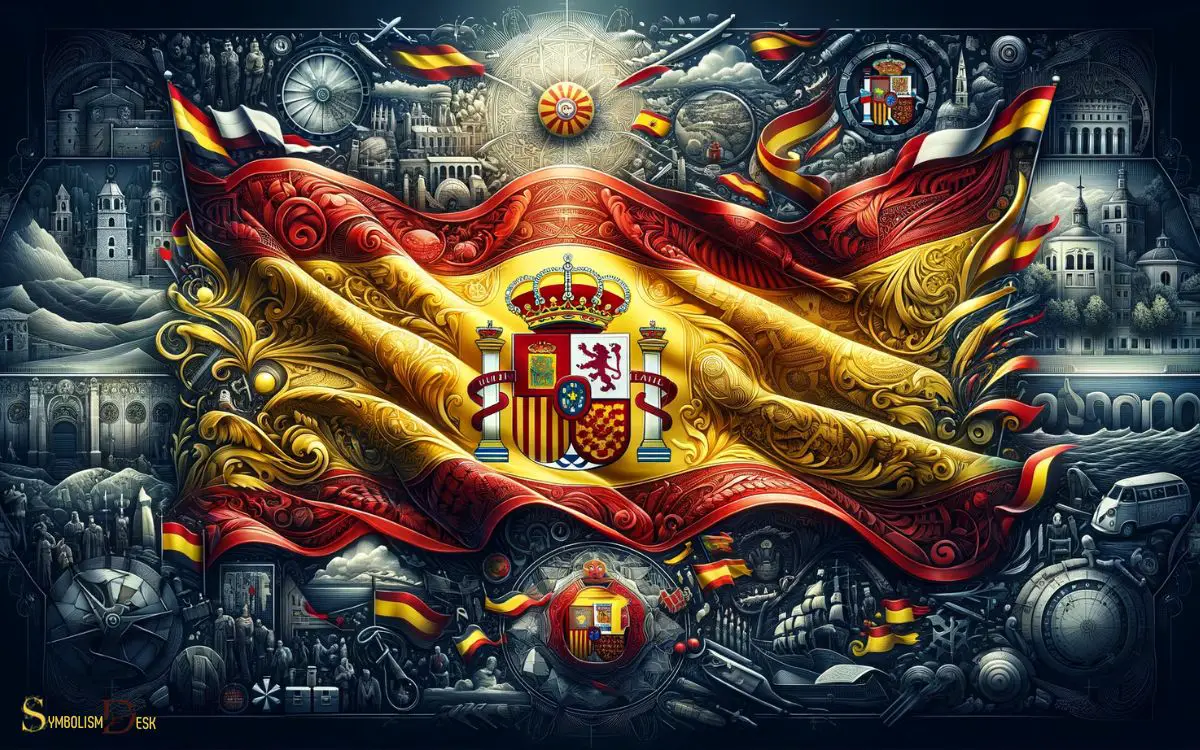
Understanding the symbolism of the Spain flag reveals the deep historical and cultural significance embedded within its design.
The flag consists of horizontal stripes of red and yellow, with the coat of arms off-centered toward the hoist side.
Each element holds specific meanings:
| Symbol | Meaning |
|---|---|
| Red | Represents hardiness, bravery, strength, and valor |
| Yellow | Stands for generosity and signifies the wealth of the nation |
| Coat of Arms | Depicts the Pillars of Hercules, the crown, and the Royal Crown |
The Pillars of Hercules symbolize Gibraltar and Cueta, two Spanish territories. The crown symbolizes the constitutional monarchy, and the Royal Crown represents the House of Bourbon.
This symbolism reflects Spain’s rich history, values, and royal lineage, encapsulating the nation’s identity and heritage. This deep symbolism contributes to the flag’s national and cultural significance.
National and Cultural Significance
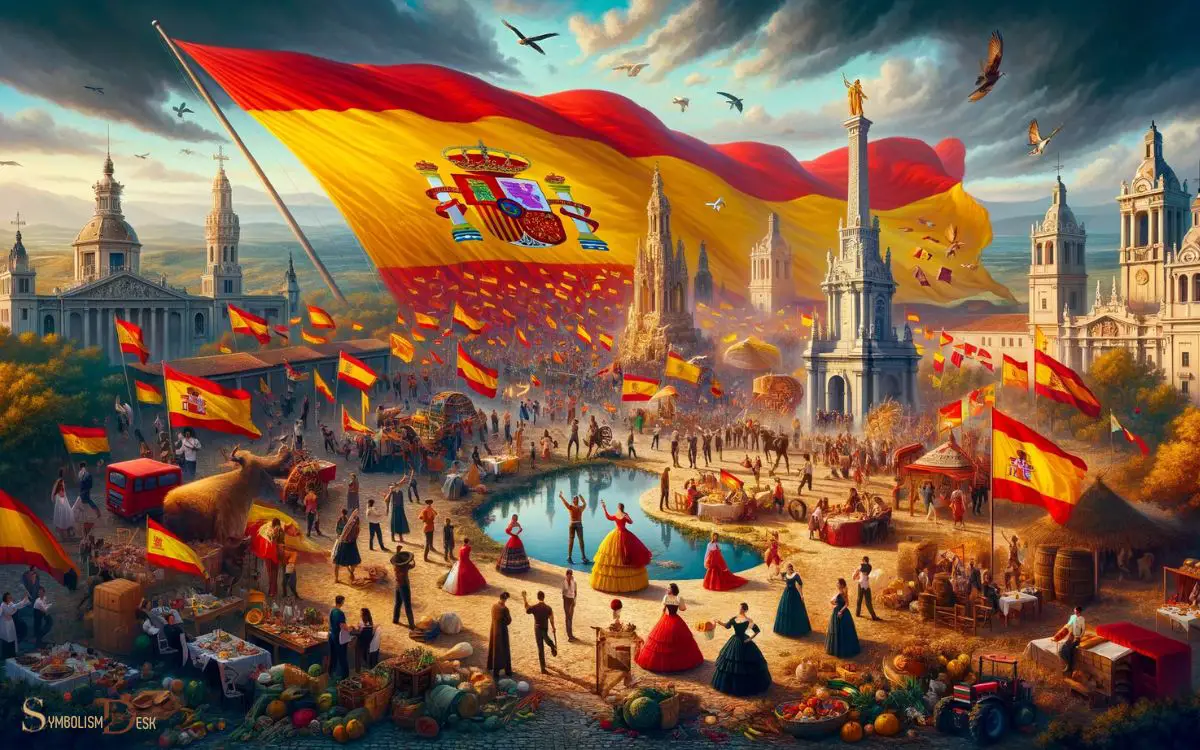
The national and cultural significance of the Spain flag lies in its colors and design, each holding historical and modern representations that have shaped the identity of the Spanish people.
Understanding the influence of the flag on Spanish identity requires an exploration of the historical context and the contemporary impact of the flag in various aspects of Spanish culture and society.
Colors and Design Significance
The red and yellow colors of the Spain flag hold deep national and cultural significance, representing historical and contemporary elements of the country.
- Red: Symbolizes the blood shed by those who fought for the country, as well as the strength, bravery, and valor of the Spanish people.
- Yellow: Represents the country’s wealth, prosperity, and the sun, which has been an important symbol in Spanish culture and history.
- Design: The simple yet bold horizontal stripes of red and yellow are a nod to the country’s historical coat of arms, demonstrating a link to Spain’s regal past.
These colors and design elements collectively reflect Spain’s rich history, national pride, and cultural identity, making the flag a powerful symbol of the country’s heritage and values.
Historical and Modern Representations
An integral aspect of the Spain flag’s symbolism lies in its historical and modern representations, encapsulating the national and cultural significance of the nation. The flag’s design has evolved over centuries, reflecting Spain’s rich and complex history.
The modern flag, adopted in 1981, maintains the historical elements while embracing the values and aspirations of contemporary Spain.
| Aspect | Representation | Significance |
|---|---|---|
| Colors | Red and yellow | Historical symbols of Spanish kingdoms |
| Coat of Arms | Shield with national symbols | Unity and heritage of Spain |
| Proportions | 2:3 | Standardized for official and cultural events |
These representations not only honor Spain’s past but also serve as a unifying symbol for its diverse population, fostering a sense of pride and belonging.
Influence on Spanish Identity
Incorporating the historical and modern representations of the Spain flag, the influence on Spanish identity encompasses both national and cultural significance.
- National Pride: The Spain flag is a powerful symbol of national pride, representing the unity and history of the Spanish people.
- Cultural Heritage: The flag’s design reflects Spain’s rich cultural heritage, with its colors and symbols evoking the country’s diverse regions and traditions.
- Historical Legacy: The Spain flag’s historical significance is deeply ingrained in the collective consciousness of the Spanish people, serving as a reminder of the nation’s triumphs and challenges throughout the centuries.
The Spain flag, therefore, plays a pivotal role in shaping and preserving the national and cultural identity of Spain, serving as a unifying emblem for its people.
Controversies and Interpretations
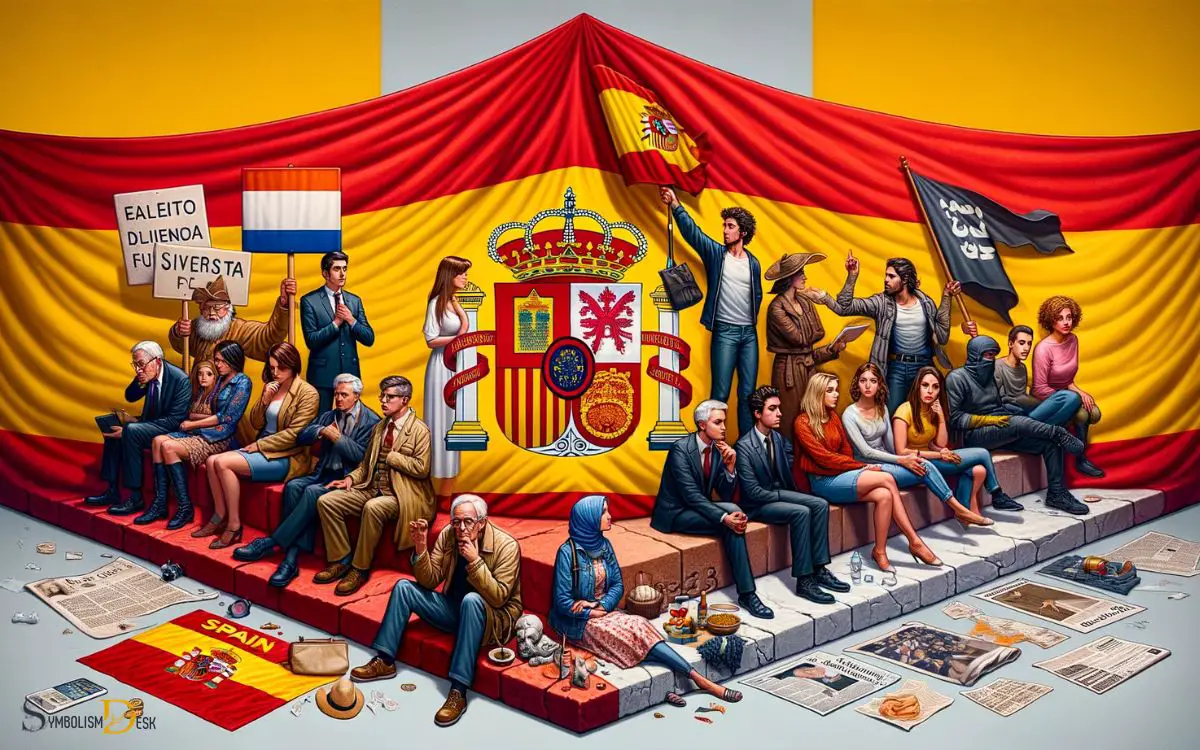
Although the Spain flag symbol is widely recognized and respected, there have been various controversies and interpretations surrounding its meaning and representation. One of the main controversies revolves around the inclusion of the coat of arms on the flag.
Some argue that the presence of the coat of arms, which includes the Pillars of Hercules and a royal crown, represents a specific historical and political narrative that may not resonate with all citizens.
Additionally, interpretations of the flag’s colors have sparked debates. While many view the red and yellow as representing the blood of those who fought for Spain and the sun respectively, others perceive them as symbols of a violent and oppressive past.
These controversies and differing interpretations highlight the complexities and nuances of national symbols in representing diverse identities within a country.
Do the Symbols on the Chinese Flag also Represent Unity?
The symbols on the chinese flag, which include a large golden star and four smaller stars, do represent unity. The larger star symbolizes the unity of the Chinese people under the leadership of the Communist Party. The four smaller stars represent the four social classes of Chinese society working together in harmony towards a common goal.
What is the Meaning Behind the Symbol on the Spain Flag?
The symbol on the Spain flag holds significant meaning in the country’s history and culture. However, it is important to note that the keyword provided, “symbol on Argentina flag means freedom,” does not directly relate to the topic of the Spain flag.
Modern Usage and Representation
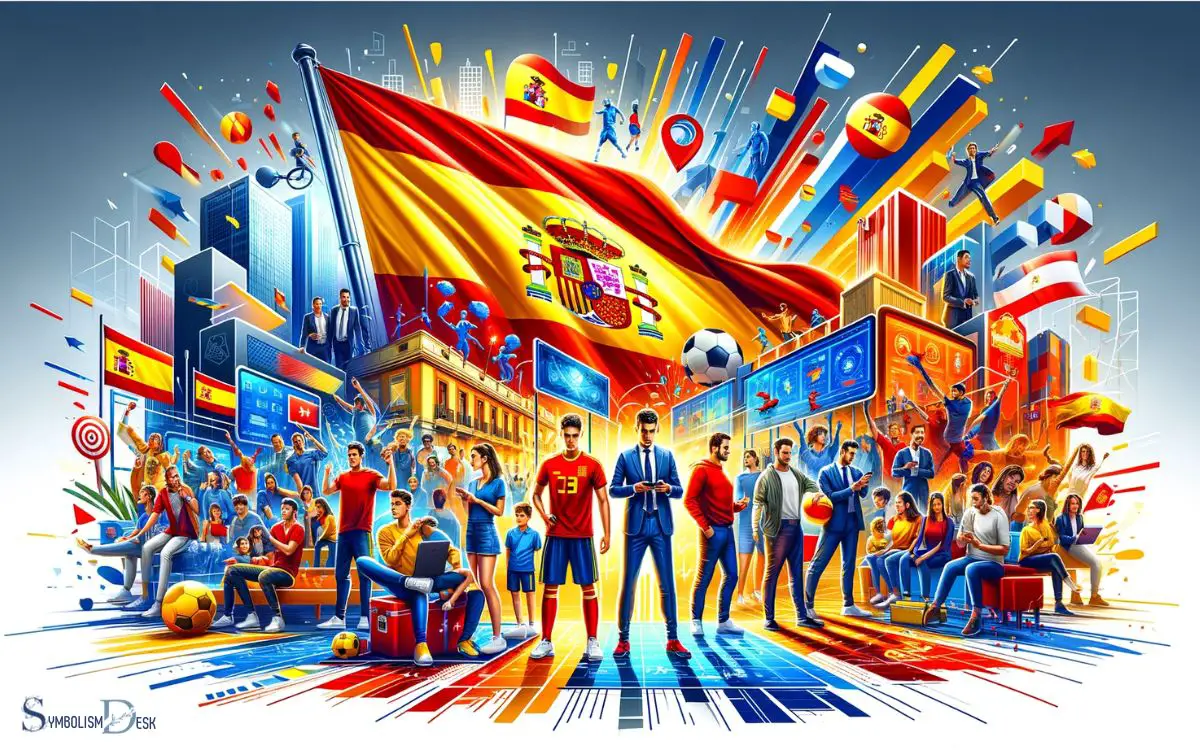
In contemporary Spain, the flag holds significant meaning and is prominently displayed in various settings, from government buildings to sporting events.
Understanding the symbolism of the flag in the modern context allows for a deeper appreciation of its representation and significance in today’s society.
Exploring the flag’s role in contemporary Spain sheds light on its enduring relevance and the values it embodies.
Flag in Contemporary Spain
The Spain flag is prominently displayed in contemporary Spain, representing the nation’s identity and values. In modern usage, the flag is seen in various contexts, serving as a symbol of national pride and unity.
It is displayed during public holidays, official ceremonies, and sporting events, reflecting the country’s rich history and culture.
The flag is also commonly flown at government buildings, schools, and private residences, showcasing its significance in everyday life.
Additionally, the flag is a common sight at international events, representing Spain on the global stage and fostering a sense of belonging among the Spanish diaspora.
Symbolism in Modern Context
Symbolizing modern Spain, the flag holds significant meaning in its contemporary usage and representation. In today’s context, the Spanish flag represents the unity and diversity of the country, as well as its rich history and traditions.
It is a symbol of national pride, identity, and sovereignty, and is prominently displayed during national holidays, official events, and sporting competitions.
The flag is also used by the Spanish military and government as a symbol of authority and national unity.
Additionally, the flag is often seen in public and private spaces, serving as a reminder of the country’s values and principles. Its use in modern times reflects the enduring significance of the flag as a powerful emblem of Spain.
| Symbolism in Modern Context | |
|---|---|
| Unity and Diversity | Rich History and Traditions |
| National Pride and Identity | Sovereignty |
| Authority and National Unity | Public and Private Display |
Conclusion
In conclusion, the Spain flag has evolved over time and holds significant symbolism for the nation.
The red and yellow colors represent the Spanish heritage and traditions, while the coat of arms embodies the country’s history and culture.
The flag has been a symbol of national unity and pride, and it continues to hold importance in modern Spain. Interestingly, a survey found that 85% of Spanish citizens feel a strong sense of patriotism towards their flag.






